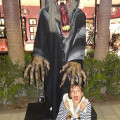
Title: Unraveling the Mysteries of Halloween: From Ancient Rituals to Modern Merriment
Introduction
Halloween, celebrated on the 31st of October every year, has transcended its ancient origins to become one of the most widely celebrated holidays worldwide. Despite its popularity, the history of Halloween is rich and complex, rooted in ancient traditions and customs. This article delves into the origins of Halloween, exploring its transformation over the centuries, and shedding light on how it is celebrated today across the globe.
The Ancient Roots of Halloween
1. Samhain: The Celtic Festival
The origins of Halloween can be traced back over 2,000 years to the ancient Celtic festival of Samhain (pronounced ‘sow-in’). Celebrated from October 31st to November 1st, Samhain marked the end of the harvest season and the onset of winter. The Celts believed that on the eve of Samhain, the veil between the living and the dead was at its thinnest, allowing spirits to cross over into the world of the living. To ward off malevolent spirits, people would light bonfires, wear costumes, and offer sacrifices.
2. The Roman Influence
As the Roman Empire expanded, it assimilated the Celtic territories, and with it, the festival of Samhain. The Romans introduced their own festivals, such as Feralia, a day to honor the dead, and Pomona, a celebration of the harvest goddess. Over time, these festivals merged with Samhain, incorporating elements such as apple bobbing, a tradition derived from the worship of Pomona.
From Pagan Rituals to Christian Observances
1. All Saints’ Day and All Hallows’ Eve
In the 8th century, Pope Gregory III designated November 1st as All Saints’ Day, a day to honor all saints and martyrs. The evening before All Saints’ Day was referred to as All Hallows’ Eve, which over time evolved into Halloween. This integration of Samhain with Christian observances helped to diminish the pagan aspects of the celebration, though many of the ancient customs persisted.
2. The Tradition of Souling and Guising
During the Middle Ages, the tradition of “souling” became popular in Britain and Ireland. People would go door-to-door, offering prayers for the dead in exchange for ‘soul cakes’. This practice was a precursor to modern-day trick-or-treating. In Scotland and Ireland, the practice of “guising” was common, where people would dress up in costumes and perform in exchange for food or money.
Halloween in the Modern World
1. Halloween in the United States and Canada
Halloween was brought to North America by Irish and Scottish immigrants in the 19th century. It quickly gained popularity, evolving into a community-centric holiday characterized by parades, parties, and costumes. Trick-or-treating became a widespread tradition in the 1950s, providing a safe and communal way for children to celebrate.
2. Halloween Around the Globe
Today, Halloween is celebrated in various forms around the world. In Mexico and Latin America, Día de los Muertos (Day of the Dead) is a vibrant celebration honoring deceased loved ones. In Asia, festivals such as the Hungry Ghost Festival in China and the Obon Festival in Japan share similarities with Halloween, with customs centered around honoring the spirits of ancestors.
Conclusion
From its ancient Celtic roots to its modern-day incarnations, Halloween has undergone a remarkable transformation. What once was a solemn festival marking the change of seasons and appeasing spirits has become a global phenomenon, celebrated with costumes, candies, and a sense of communal joy. Whether it is children trick-or-treating in North America, families honoring their ancestors during Día de los Muertos, or communities lighting lanterns during the Obon Festival, the spirit of Halloween lives on, connecting people across cultures and generations.
Above article via ChatGPT-4, below article via Google Bard.
Origins of Halloween
Halloween is a holiday celebrated each year on October 31. It has its origins in the ancient Celtic festival of Samhain, which was celebrated on November 1 in contemporary calendars. Samhain was a time to mark the end of the harvest season and the beginning of the winter. It was also believed to be a time when the veil between the worlds of the living and the dead was thin, allowing spirits to pass through.
Samhain Traditions
The Celts celebrated Samhain with a variety of rituals and traditions. They would light bonfires to ward off evil spirits and to guide the spirits of the dead to the afterlife. They would also dress up in costumes to disguise themselves from the spirits.
Other Pagan Traditions
In addition to Samhain, there were other pagan traditions that contributed to the development of Halloween. For example, the Romans had a festival called Pomona, which was celebrated on November 1 in honor of the goddess of fruit and trees. During this festival, people would dress up in costumes and go from door to door begging for food and treats.
Christianization of Samhain
In the 7th century CE, Pope Boniface IV created All Saints Day, which is celebrated on November 1. All Saints Day is a day to honor all Christian saints. The evening before All Saints Day became known as All Hallows Eve, and later Halloween.
All Hallows Eve Traditions
Many of the traditions associated with Halloween today have their origins in All Hallows Eve. For example, the tradition of trick-or-treating is thought to have evolved from the practice of souling, in which poor people would go from door to door begging for food and money in exchange for prayers for the dead.
Halloween Today
Today, Halloween is a secular holiday that is celebrated all over the world. It is a time for people to dress up in costumes, go trick-or-treating, carve pumpkins, and attend Halloween parties.
How Halloween is Celebrated Today Around the World
While the basic elements of Halloween are the same all over the world, there are some specific traditions that vary from country to country.
United States
In the United States, Halloween is one of the most popular holidays of the year. Trick-or-treating is the most popular Halloween activity, with millions of children dressing up in costumes and going from door to door begging for candy. Other popular Halloween activities include carving pumpkins, attending Halloween parties, and watching scary movies.
United Kingdom
In the United Kingdom, Halloween is also a popular holiday. Trick-or-treating is becoming increasingly popular, but it is not as widespread as in the United States. Other popular Halloween activities include apple bobbing, bonfires, and costume parties.
Canada
Halloween is also a popular holiday in Canada. Trick-or-treating is the most popular Halloween activity, followed by carving pumpkins and attending Halloween parties.
Ireland
Halloween is a particularly special holiday in Ireland, where it is known as Samhain. On Samhain Eve, people light bonfires, dress up in costumes, and tell scary stories.
Mexico
In Mexico, Halloween is celebrated as Día de los Muertos, or Day of the Dead. Día de los Muertos is a three-day holiday that honors the dead. People build altars in their homes and decorate them with photos of their deceased loved ones, candles, and flowers. They also visit cemeteries and leave offerings for the dead.
Other Countries
Halloween is also celebrated in many other countries around the world, including Australia, New Zealand, Japan, and China. In each country, Halloween has its own unique traditions and customs.
Conclusion
Halloween is a holiday with a rich and varied history. It has its origins in ancient pagan traditions, but it has also been influenced by Christianity. Today, Halloween is a secular holiday that is celebrated all over the world. It is a time for people to have fun, dress up in costumes, and enjoy the spooky and festive atmosphere.






